Kecap Manis Recipe
This post may contain affiliate links. See my disclosure policy.
There’s a reason Kecap Manis is the most popular condiment in Indonesia: It’s not only delicious, it’s so incredibly versatile you’ll find yourself wanting to add it to nearly everything! This homemade kecap manis recipe is made from scratch and will keep in the fridge for several weeks.
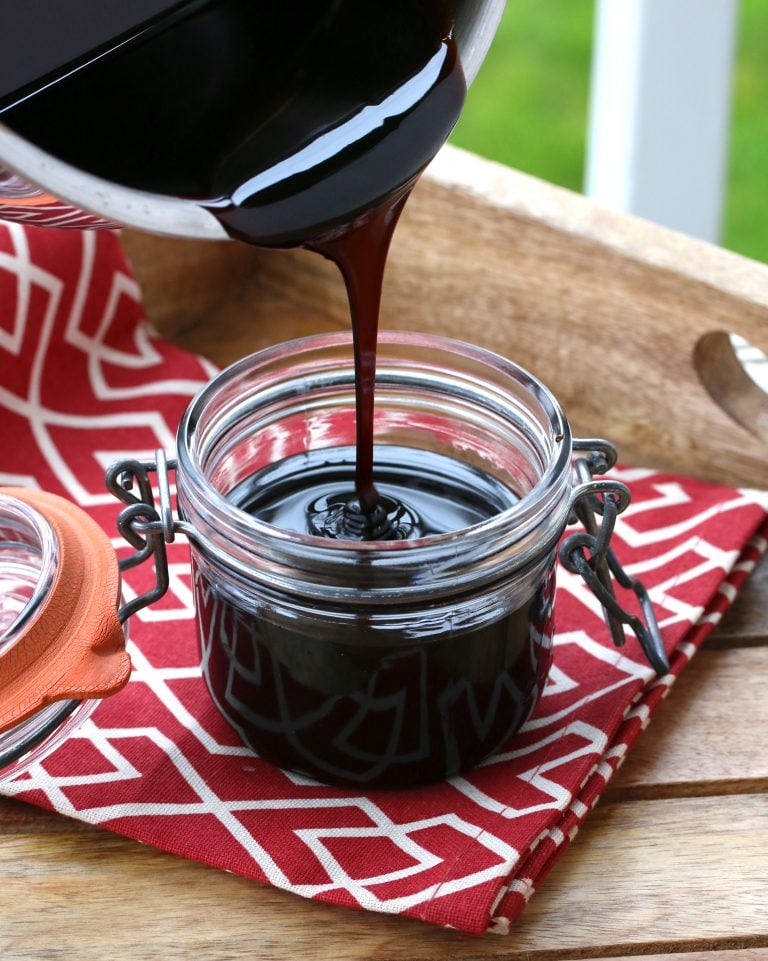
Indonesian Sweet Soy Sauce
A meal in Indonesia is virtually incomplete without ketcap manis, the most popular condiment in the country! It’s not only the most popular condiment, it’s the most widely used condiment in Indonesia. So much so that over 90% of soy sauce production in Indonesia goes towards making kecap manis. Kecap manis is such a deliciously versatile sauce and will do wonders for a vast variety of Asian-inspired dishes!
What is Kecap Manis?
Also known as ketjap manis, it’s a thick and dark molasses-like sauce with palm sugar and soy sauce as its base and with the addition of aromatic spices for flavor. The word manis means “sweet” in Malay/Indonesian and so the sauce is often referred to as “sweet soy sauce.”
The method for making it is much like a balsamic vinegar reduction wherein the ingredients are slowly simmered until the sauce naturally thickens into a syrupy consistency. Traditionally palm/coconut sugar is used which gives the sauce deep caramelly and butterscotch undertones. Kecap manis has been popular in Indonesia for…well, for a very, very long time. Interestingly it is also quite popular in the Netherlands because of the influence of Dutch colonialism in Indonesia in from the late 16th century until 1945.
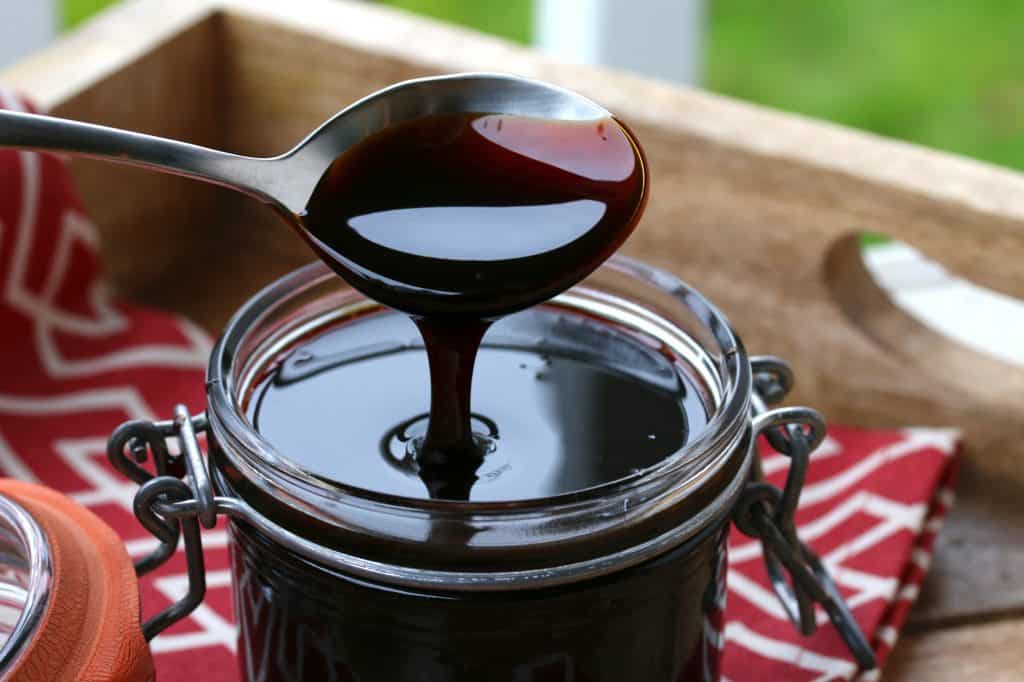
Where Did it Originate?
I recently read an article discussing the history of kecap manis in Indonesia. Though most Indonesians today buy their kecap manis in bottles at the grocery store that wasn’t always so. In earlier days it wasn’t available in bottles produced by huge manufacturers. Instead local families built their livelihood on it and produced and sold it at the local markets. The city of Majalengka alone used to have 300 different local vendors who produced their own versions of kecap manis, each with their own distinct flavor variations.
But then Heinz and Unilever took over two of the brands, ABC and Bango, and local producers couldn’t compete with their advertising power. As a result many of family-run businesses who had been making kecap manis for generations were forced out of business. Another result is that the vast variety of kecap manis sauces dwindled down to a small handful of bottled brands, the unique local variations largely lost.
Well, I’m sticking with homemade kecap manis. Not only is it free of the junk ingredients and preservatives found in the bottled versions, it also tastes MUCH better! Plus it’s super easy to make so there really just is no excuse not to make your own. With Indonesia’s past tradition of a vast variety of flavor variations, feel free to experiment with other flavors by adding ingredients like black peppercorns, chilies, coriander seeds, lemongrass and kaffir or curry lime leaves.
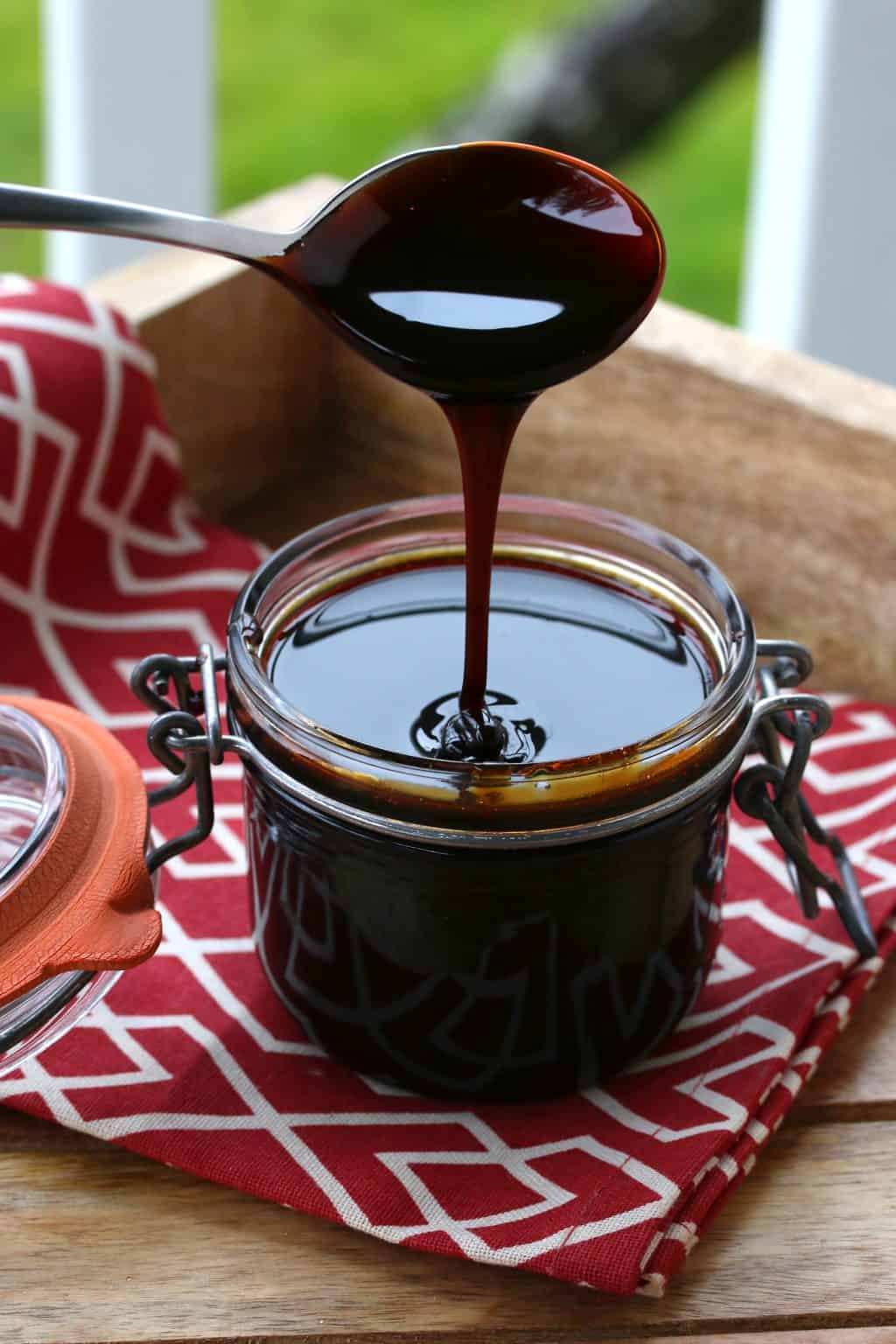
Kecap Manis Recipe
Let’s get started!
Place all ingredients in a small saucepan and bring to a boil. Reduce the heat to medium-low and simmer uncovered, stirring frequently, until the sugar is dissolved and sauce begins to thicken, 10-15 minutes.
Note: The sauce will continue to thicken as it cools so be careful not to over-cook it. But you can get an idea of its thickness by placing a place in the freezer for a few minutes and then spooning a little sauce onto it to see how thick it is when it cools.
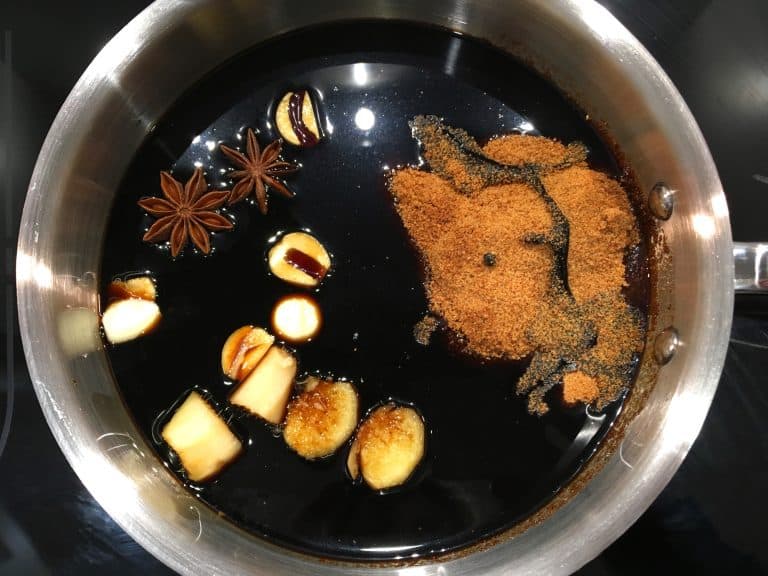
Turn off the heat, cover and let cool completely with the spices, garlic and ginger still in it so they can continue to release their flavors.
Once cool, discard the pieces, pour the sauce into an airtight jar and store in the fridge. It will keep for several weeks.
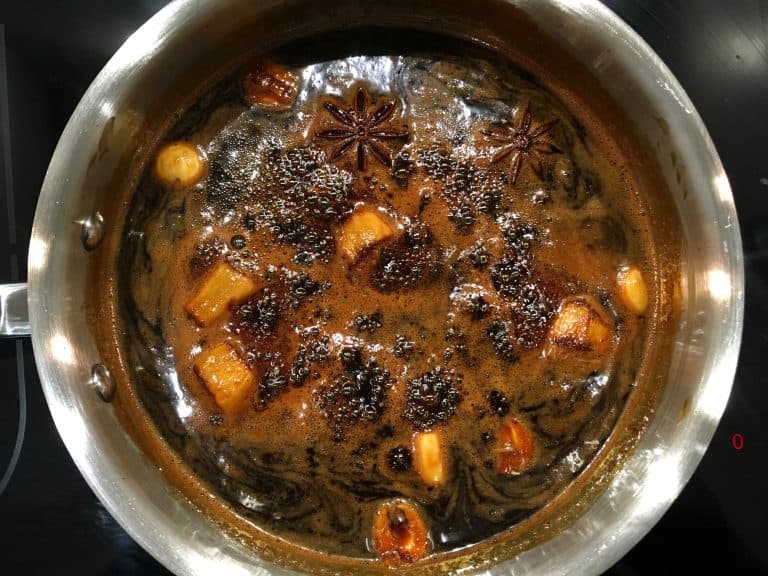
How to Use Kecap Manis
This is one deliciously versatile sauce! It is a central ingredient in the national dish of Indonesia, nasi goreng (fried rice), as well as mie goreng (fried noodles). It’s also commonly used in satays. Try adding it to Asian-style salad dressings, peanut sauces, drizzled over sandwiches, added to scrambled eggs, lightly brushed on grilled corn on the cob, grilled chicken, pork, beef, fish and seafood…the sky’s the limit!
Bottom line: Kecap Manis does wonders for rice and noodle dishes and is equally fantastic added to stir-fries or used in marinades, glazes, soups and barbecue sauces or used as a dipping sauce.
Enjoy!
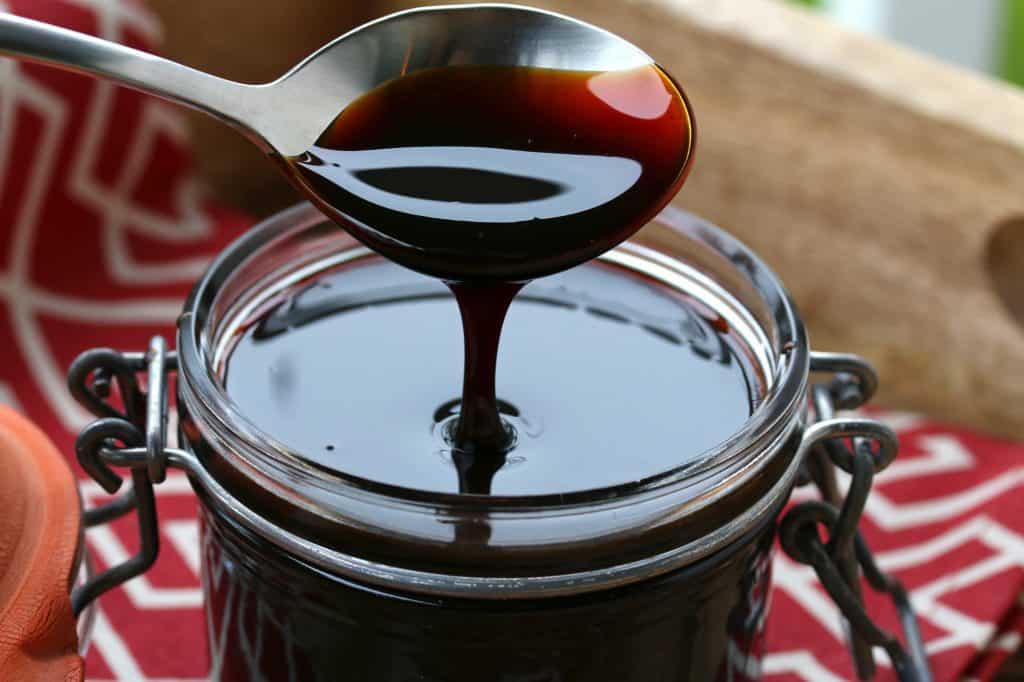
For more delicious sauces from around the world try my:
- Sweet and Sour Sauce
- Teriyaki Sauce
- Yum Yum Sauce
- Hoisin Sauce
- Aji Verde
- Romesco Sauce
- Sriracha Mayo
- Black Bean Sauce
- Eel Sauce
- Plum Sauce
- Sweet Chili Sauce
- Ponzu Sauce
- Char Siu Sauce
- Ginger Sauce
Save This Recipe
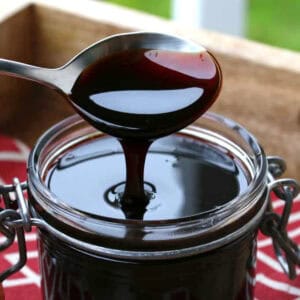
Kecap Manis Recipe (Indonesian Sweet Soy Sauce)
Ingredients
- 1 cup soy sauce (use a brand you know you like)
- 1 1/4 cup palm/coconut sugar or brown sugar
- (Note: Palm/coconut sugar has a rich caramel/butterscotch flavor whereas brown sugar yields a sweeter-tasting sauce, take your pick)
- 1 tablespoon molasses
- 3 cloves garlic, peeled and halved
- 2 inch piece fresh ginger, peeled and quartered
- 2 whole star anise
- 2 whole cloves
- (You can also experiment with adding ingredients like black peppercorns, chilies, coriander seeds, lemongrass, kaffir or curry lime leaves)
Instructions
- Place all ingredients in a small saucepan and bring to a boil. Reduce the heat to medium-low and simmer uncovered, stirring frequently, until the sugar is dissolved and sauce begins to thicken, 10-15 minutes. (Note: The sauce will continue to thicken as it cools so be careful not to over-cook it. But you can get an idea of its thickness by placing a place in the freezer for a few minutes and then spooning a little sauce onto it to see how thick it is when it cools.)
- Turn off the heat, cover and let cool completely with the spices, garlic and ginger still in it so they can continue to release their flavors. Once cool, discard the pieces, pour the sauce into an airtight jar and store in the fridge. It will keep for several weeks. Makes about 1 cup.
Nutrition
Originally published on The Daring Gourmet March 22, 2018



















This kecap manis is super yummy and surprisingly easy to make! Thank you!
Thank you so much, Sonja!
Is this the same sauce in the squirt bottle that I put on sticky rice at the bento place?
The flavor was great but next time I will use low sodium soy sauce. Mine was way to salty. Could have been the brand but the flavor overall was better then store bought.
This tastes just like the sweet soy sauce I buy at the Thai store. Delicious! Thank you!
The flavor of the spices really comes through and the overall flavor is well-balanced and so delicious. This is my new favorite sauce! Love it drizzled over rice, chicken or pork.
Thank you, Renae, I’m so glad you enjoyed it!
This sauce is terrific! Really nice combination of sweet, salty and savory and I’m finding myself using it as a general flavor booster for a lot of dishes.
Let’s stick to homemade because the store-bought has so much junk in it!
.
.
.
.
Ingredients
1 cup soy sauce (use any brand you like)
big LOL
Soy sauce is one of the world’s oldest condiments and has been used in China for over 2,500 years. Unless you’re buying some garbage brand, soy sauce is a natural product made from fermented soybeans. The particular brand I use has been made by the same family in Japan for generations and they still ferment it the old-fashioned way in wooden barrels. But hey, if you prefer to make your own soy sauce, here’s the recipe. Then after the upwards of one year process you can come back and use it to make this homemade Kecap Manis ;)
Ingredients:
2 cups soybeans
2 cups wheat berries
1 cup salt
Water
Instructions:
Rinse the soybeans and wheat berries under cold water, then soak them separately overnight in water.
Drain the soaked soybeans and wheat berries. Place them in separate saucepans and add enough water to cover them. Bring to a boil, then reduce heat and simmer for about 2 hours or until they are fully cooked and soft.
Once cooked, drain the soybeans and wheat berries and allow them to cool.
In a large pot, combine the cooked soybeans and wheat berries. Add salt and mix well.
Transfer the mixture to a large fermentation container. Ensure the container is clean and sanitized.
Cover the container with cheesecloth or a fine mesh strainer to allow air circulation while keeping out contaminants.
Place the container in a cool, dark area with a consistent temperature between 77°F and 86°F (25°C to 30°C).
Fermentation will take several months. During this time, stir the mixture regularly to prevent the growth of unwanted mold and ensure even fermentation.
As fermentation progresses, a liquid called “moromi” will develop. It may take several months for the moromi to separate into liquid and solids. The liquid is the soy sauce.
After the fermentation period, strain the liquid through cheesecloth or a fine mesh strainer to separate it from the solids.
Transfer the liquid to a saucepan and bring it to a simmer. Cook for a few minutes to kill any remaining bacteria or microorganisms.
Allow the soy sauce to cool completely. It can be used immediately, but for better flavor, transfer it to a clean, sterilized container and age it in a cool, dark place for at least a month.
I just made this as I can’t fund it in the Asian Stores. I added black pepper corns and chillies flakes. Going to use it in my Nasi Goreng recipe tonight. It looks and tastes yummy! Thanks for the Recipe.
Thank you, Louise, I’m so glad you enjoyed it!
I can,t buy molasses either in Cebu province but i used Muscovado , it taste perfect. Thank you
Mucovadois a type of partially refined to unrefined sugar with a strong molasses content and flavour, and dark brown in colour. It is technically considered either a non-centrifugal cane sugar or a centrifuged, partially refined sugar according to the process used by the manufacturer.Muscovado contains higher levels of various minerals than processed white sugar, and is considered by some to be healthier.. Its main uses are in food and confectionery, and the manufacture of rum and other forms of alcohol. The largest producer and consumer of muscovado is India.
Do you mean 1 1/4 cup sugar or 1/4 cup? More sugar than soy sauce!
Hi Petrer, 1 1/4 cups of sugar is correct. Note that this sauce is known as Indonesian SWEET Soy Sauce.
Really awesome! I made this in order to try a recipe from To Asia, With Love by Hetty McKinnon
I’m so glad you enjoyed this sauce, Bridget, thank you!
I can’t find molasses in Italy. What can I use as a substitute?
Hi Debora, from what I’ve heard you can find molasses (“melassa”) at NaturaSi in Italy. There are other dark syrups throughout Europe (like Graftschafter sugarbeet syrup in Germany and aapelstroop in the Netherlands) and would imagine Italy has something similar as well but I’m not sure what the exact product is. If all else fails, here are some other substitutes you can try: https://www.thepioneerwoman.com/food-cooking/cooking-tips-tutorials/g34590789/molasses-substitute/
This tastes just like the sweet soy sauce I buy at the Thai store. Delicious! Thank you!
I’m so glad you enjoyed it, Melissa, thank you!
Interesting, I live in Thailand and can not find and therefor use this amazing recipe :)
I cant have garlic will it that away from the taste?
Hi Brooklyn, the garlic obviously contributes flavor but the sauce will still taste good without it.